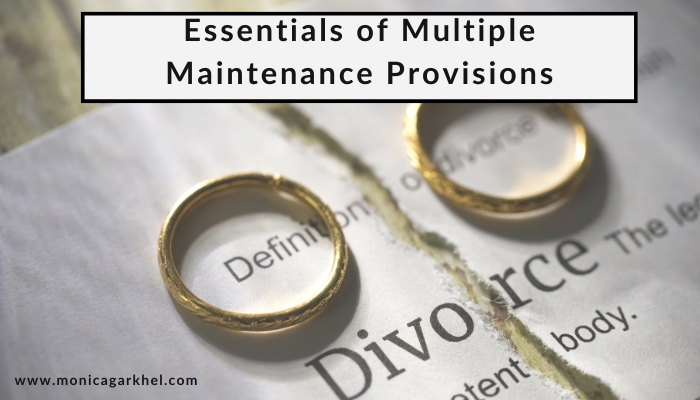The process of getting a divorce always involves talking about alimony, maintenance, and other relevant issues. When one spouse cannot support themselves, they receive financial support from the other, known as maintenance.
It is the amount routinely given to one spouse or during a legal proceeding. In contrast, alimony is a one-time payment given to one spouse following a divorce. On the one hand, maintenance payments have to be made exclusively in cash, but alimony payments can be made in both property and cash.
I will answer all your questions on the significance of various maintenance clauses here. You can get in touch with Monika Grakhel for additional advice on this. Monika Garkhel is a Gender Equality Crusader and a Relationship Counsellor. I can help you if you feel like you are stuck in the murky waters of unfair maintenance and alimony.
Types of Maintenance Provisions
Alimony or Spousal Support
Spousal support, often known as alimony, is money given by one spouse to the other throughout the divorce process. It is meant to support a spouse whose income is lower or who did not work during the marriage in meeting their necessities. During the divorce process, the lower-income spouse may request payments, or a judge may approve payments upon request.
The conditions and procedures for alimony are different for each state. When assessing spousal support, courts typically consider several factors, including the length of the marriage, age, earning capacity, etc. However, since each state has its own set of rules, it is always advisable to speak with a local, competent attorney.
Child Support
The parents are required under Indian family and public policy regulations to give child support to maintain their child. The non-custodial parent must pay the child and provide financial support for the child’s benefit. Whether the couple is married or not, this happens after they split up.
The obligator guardian of the kid must pay child support annually and constantly. Additionally, the guardian must use this feed for the child’s upkeep and care. The amount of child support is determined by various criteria, including parents’ income, the number of children, the child’s schooling, health insurance, other assets and liabilities of the parents, and the other child’s requirements.
Temporary and Permanent Maintenance
In temporary maintenance, a more financially stable partner pays the amount to cover the requirements and necessities of the other partner throughout the divorce process. The court determines this sum. Any such provision is motivated by the idea that neither party should be in a weaker position to argue their case.
Temporary maintenance is granted after the court petition is filed. Although the woman typically files for temporary maintenance, no law prohibits the husband from doing the same. The husband may also ask for interim maintenance if he cannot provide for the child and himself.
Where interim maintenance is provided during court proceedings, the court will order permanent maintenance to be paid at regular intervals following the divorce. The payor can only pay in cash for ongoing maintenance. The court determines the amount of permanent maintenance after examining several factors.
Common Elements of Maintenance Provisions
Amount and Duration
When assessing spousal maintenance or support, courts typically consider the following factors; however, as they vary by state, it is best to speak with a qualified local attorney.
- Duration of the marriage.
- The individuals’ ages and health
- Property division
- Each party’s educational background, both at the time of the marriage and the start of the action
- Earning potential of each party
- The likelihood that the party requesting maintenance or alimony will be able to sustain themselves at a level of living roughly equivalent to what they experienced during the marriage, as well as the amount of time required to do so.
- Tax ramifications for each party.
- Any agreements made both before or after marriage
- Contribution made by one party to the other’s education, training, or more significant earning potential; any additional information the court deems pertinent
After a party is found eligible for alimony, the court decides how much the recipient should get each month and for how long.
The length of the marriage usually determines the amount and duration of alimony. Those in marriages that have lasted longer than ten years are eligible for lifetime alimony.
When determining alimony, the court also considers the spouse’s age. Suppose the court determines that a young beneficiary of alimony will soon be able to become financially sound through future professional brilliance. In that case, the recipient often receives alimony for a brief period.
The court may deny the spousal support if the court determines that the partner requesting it is self-sufficient and financially stable and won’t require the money to support their lifestyle in any way.
Modification and Termination
When the payee gets married again or starts living with a new romantic partner, alimony usually ends. Both parties’ deaths mark the conclusion of the story.
If either spouse’s financial situation changes, the payor spouse may also file a petition with the court to request a modification of the alimony order.
Tax Implications
The Income Tax Act of 1961 does not contain any specific provisions governing the taxability of alimony. All that matters in terms of alimony taxability is the mode of payment. Our comprehension of the same has also improved due to previous decisions made in other situations.
When alimony is paid in one lump sum, it is considered a capital receipt and is not subject to the Income Tax Act of 1961’s regulations. As a result, it is not taxable or considered income.
If alimony is paid regularly, it is seen as a revenue receipt. As a result, it is regarded as income that the recipient must pay taxes on. However, it is essential to note that the individual who pays the alimony cannot claim a deduction.
Any asset transferred to the recipient before the divorce will not be subject to tax. The rationale is that under Section 56(ii) of the Income Tax Act, 1961, the asset so transferred will be deemed to have been received as a gift from family and will, therefore, be exempt. However, after a divorce, the “relative” part of the transaction no longer exists, and as a result, the transfer is considered taxable in the recipient’s eyes.
Legal Considerations
- Legal Requirements: As maintenance regulations differ significantly from one jurisdiction to the next, verifying that the maintenance provisions are according to the state’s laws in which the agreement will be implemented is critical.
- Court Approval: Even if both parties agree to a maintenance plan, the court will usually assess it to verify that it is equitable and does not unfairly disadvantage one side. Courts can change maintenance conditions if they believe they are unreasonable or violate legal principles.
- Enforcement: There are legal mechanisms to enforce a maintenance order if a party fails to comply. It can entail wage garnishment, property liens, and contempt of court procedures. Maintenance orders are sometimes adjusted if there is a significant change in circumstances, such as a considerable change in income, remarriage, or changes in the parties’ requirements.
Legal remedies for non-payment of maintenance
The court may issue an arrest warrant for the husband if he disobeys the maintenance order and neglects to carry out his obligations. Additionally, the court may seize the husband’s assets to recoup the money in cases of such noncompliance.
To ensure its decision is followed, the court may impose several options on the husband in place of his non-payment of support.
Suppose there has been a substantial drop in the paying party’s income or another legitimate change in circumstances leading to non-payment. In that case, the court may sometimes consider this while altering the initial maintenance order. But usually, this adjustment calls for substantial support and reasoning.
Negotiation and Drafting Tips
- Understand the financial status of both of you completely. It includes income, spending, assets, and liabilities.
- Consider your future financial requirements, such as inflation, health care, and retirement.
- Maintain an open and honest conversation about your expectations and constraints.
- Prepare to make concessions while keeping the ultimate goal of a fair settlement in mind.
- A neutral third party can assist in bridging divides and facilitating a more amicable agreement.
- Always have legal representation to protect your rights, and the process follows legal guidelines.
- Clearly clarify the quantity, period, and conditions for changing or terminating maintenance.
- Check if the agreement is by local and state regulations.
- Consider prospective changes in circumstances, such as remarriage, cohabitation, large income changes, or health concerns.
- Include provisions for periodic evaluation and possible modification of maintenance terms.
- Avoid using vague wording, which might lead to future disagreements.
- Consider the taxation of maintenance payments and draft the agreement properly.
- Make preparations for life insurance or other securities to guarantee maintenance payments in the event of an unforeseen event.
- Inadequate maintenance provisions might stem from failing to account for long-term financial demands.
Conclusion
In most cases, divorce is a very nasty process that brings out things like maintenance provisions. Various maintenance provisions include alimony, child support, and permanent spousal support. What maintenance you will have to pay or receive will depend on various factors, so it is always better to get legal guidance as it can save you from false traps in the form of legal actions.
I, Monika Garkhel, can help you with the complexities of maintenance clauses in marital agreements and divorce settlements. I ensure all your interests are protected, and your voice is heard. I provide legal and emotional support, helping clients navigate this challenging period more quickly and confidently.


